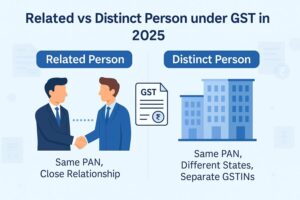Know About the Nature of Business Activity in GST Registration
- 18 Jun 25
- 11 mins

Know About the Nature of Business Activity in GST Registration
- Nature and Scope of GST Registration
- Who Should Register Under GST?
- What Are the State/UT-wise Threshold Limits Under GST?
- Who Is Not Required to Register Under GST?
- Exemptions Under GST Registration
- Aggregate Turnover Computation to Decide Threshold
- Compulsory Registration Irrespective of Threshold
- Time Limit and Procedure for Registration
- Voluntary Registration
- Distinct Persons
- Conclusion
Key Takeaways
- Understand how your business activity type determines your GST registration requirements!
- Learn why the nature of business matters when registering under India’s GST regime.
- From turnover thresholds to state-specific rules—get GST-ready the smart way!
- Unlock GST benefits: Know when and how to register your business efficiently.
- Simplify GST compliance by identifying your core business activity accurately.
The Goods and Services Tax (GST) is a multi-phase, destination-based tax applied to the supply of goods and services throughout India. For any business operating in the country, GST registration is a crucial legal requirement. As per the Central Goods and Services Tax Act, 2017, businesses with an annual turnover above ₹40 lakh (or ₹20 lakh in certain special category states) must register under GST.
In this blog, we will explore how the nature of business activity in GST registration plays an important role.
Nature and Scope of GST Registration

GST registration is based on your PAN and is specific to each State or Union Territory where you operate. You must register separately in every State or UT from where you supply goods or services. Upon registration, you receive a 15-digit GST Identification Number (GSTIN) and a registration certificate.
The first two digits of the GSTIN represent the State code, the next ten are your PAN, followed by two digits for the entity code, and the last digit is a check sum number.
A PAN-based legal entity is assigned one GSTIN per State. This means that if a business entity has branches across multiple States, it must obtain separate GST registrations for each State. However, within a State, one registration is enough, with the main branch as the principal place of business and others as additional locations.
If you want separate registrations for multiple places in the same State, you must meet specific conditions and cannot opt for the Composition Levy Scheme. SEZ units need a separate GST registration.
Who Should Register Under GST?
A person making a taxable supply of goods or services or both shall register himself with the respective authority in the State or Union Territory from where he makes taxable supply if the aggregate turnover in a financial year exceeds ₹20 lakh as per Section 22.
If your business is transferred to a different person then that person is also liable for registration under GST law. ‘Aggregate turnover’, also refers to the supplies made by the taxable person or anyone else on his behalf.
What Are the State/UT-wise Threshold Limits Under GST?
Different states have different threshold limits under Section 22 of the GST Act. As per the latest amendment, there are 4 special states for whom the threshold limit is less. They are as follows:
| Name of State | Threshold Limit for Goods (in ₹) | Threshold Limit for Services (in ₹) |
| Nagaland | 10 Lakh | 10 Lakh |
| Mizoram | 10 Lakh | 10 Lakh |
| Manipur | 10 Lakh | 10 Lakh |
| Tripura | 10 Lakh | 10 Lakh |
| Arunachal Pradesh | 20 Lakh | 20 Lakh |
| Assam | 40 Lakh | 20 Lakh |
| Telangana | 20 Lakh | 20 Lakh |
| Meghalaya | 20 Lakh | 20 Lakh |
| Sikkim | 20 Lakh | 20 Lakh |
| Uttarakhand | 20 Lakh | 20 Lakh |
| Himachal Pradesh | 40 Lakh | 20 Lakh |
Other states have a threshold limit of ₹40 lakh for goods and ₹20 lakh for services/mixed products. This threshold limit is also influenced by the nature of business activity in GST registration.
The increased threshold of ₹40 lakh does not apply to individuals subject to compulsory registration under Section 24 of the CGST Act or those who opt for voluntary registration.
Who Is Not Required to Register Under GST?

If your business's aggregate turnover does not exceed ₹40 lakh in normal category states and ₹20 lakh in special category states then you do not have to register for GST. However, small businesses can voluntarily opt to register. This helps them in availing of input tax credit benefits.
Moreover, people engaged in making non-taxable supplies such as petrol are not liable for registration under GST law. The threshold applies to a person which is defined in a wide manner to include individuals, firms, LLPs, companies and so on. Additionally, agriculturists also do not have to register to supply essential items.
Exemptions Under GST Registration
Any person or nature of business activity in GST registration that does not cross the aggregate turnover of ₹40 lakh is exempt from registration. This is applicable except for the following:
● Under Section 24 of the GST Act, persons conducting a particular nature of business are required to register.
● People who engage in intra-state supply in the states of Manipur, Meghalaya, Pondicherry, Sikkim, Telangana, Arunachal Pradesh, Uttarakhand and Tripura.
● People supply tobacco or tobacco substitutes, ice cream or other edible ice products.
● Under Section 25C, people who have voluntarily registered and wish to continue with their registration.
● If you engage in handicraft business inter-state where the products are made predominantly by hand, then you fall under the casual taxable person category and are not required to register under GST.
● If you are a job worker, supplying products or services inter-state, then you are exempt from registration.
Aggregate Turnover Computation to Decide Threshold
When computing aggregate turnover, you need to take into account ‘all supplies’. This includes taxable and non-taxable supplies as well.
Here are the following things you should take into account when computing your threshold limit:
- Value of export goods or services
- Value of all taxable supplies excluding the value of inward supplies
- Value of inter-state supplies
- Value of exempted supplies
However, there are certain things you should not take into account while calculating annual aggregate turnover. They are:
- Value of inward supplies, where you pay reverse chargeable tax
- CGST, SGST, IGST taxes
Compulsory Registration Irrespective of Threshold
Section 24 of the GST Act calls for certain situations where GST registration is mandatory, irrespective of whether the threshold is met. They are:
● If you make an inter-state supply, you have to pay IGST.
● A casual taxable person is required to register. For example; if you engage in a fair cum sale or exhibition, you need to register yourself.
● If you are paying tax under the reverse charge, you need to register yourself.
● If you use e-commerce platforms to supply goods or services intra-state, you have to register your business.
● If you are making a supply on behalf of someone else, you need to be registered mandatorily.
Time Limit and Procedure for Registration

When you exceed the threshold level, you need to register your business in under 30 days from the date on which he became liable for registration. Here is the online procedure through which you can easily register your business under GST via the unified portal:
- Head over to the GST portal and click on 'Services'. Then click on the 'New Registration' option.
- The page will prompt you to fill in the following information: Taxpayer type, State or Union Territory, District, PAN, Legal name of your business, Email and Phone number.
- An OTP will be sent. Use this to generate the TRN number. Select on the 'Proceed' option.
- Login using the TRN number. You will now need to provide all the information shown on the screen.
- Submit them and move along to the next step. Check your declaration by visiting the 'Verification Page'. Sign the document using an e-sign, Electronic Verification Code (EVC) or Digital Signature Certificate (DSC).
- You will get your Application Reference Number (ARN) through your registered number or email.
- Once you are registered, log in to the GST portal and select your nature of business activity in GST registration. There are two types: core and non-core business.
- Selection of core business activity includes three types: Trader, Manufacturer and Service Provider.
Voluntary Registration
Voluntary registration refers to people seeking GST registration who are not required to register. Once registered, they are treated as a person registered under the Act. People may want to voluntarily register to avail tax input benefits.
Distinct Persons
A distinct person is defined as someone who has obtained registration in more than one state or Union Territory. According to Section 25(5) of the GST Act, if a distinct person owns any establishment in any state, that establishment will be treated as the property of the distinct person.
Application for Registration
If you are liable to get GST registration, then you have to declare the following in Part A of FORM GST REG-01 on the Common Portal:
● PAN
● Mobile number
● Email address
● State or UT
After completing the online verification process, a temporary reference number is generated and shared with the applicant. Using this number, the applicant must electronically submit Part B of FORM GST REG-01, ensuring it is either signed or verified through an Electronic Verification Code (EVC).
Upon submission, the system issues an acknowledgement in FORM GST REG-02. Registration must be applied for within 30 days of becoming liable. However, casual taxable persons or non-resident taxable persons must apply at least five days before the commencement of business.
Anyone supplying goods or services from India’s territorial waters must register in the coastal State or Union Territory closest to the baseline. Additionally, if an individual operates multiple business verticals within a State or Union Territory, separate registrations are required for each vertical using FORM GST REG-01.
Exemption of Distinct Persons
As per the CGST Act, an Indian company with establishments outside of India is not a distinct person. Therefore, they are separate legal entities.
Key Points to Consider While Registering Your Business
Before registering your business, it’s important to keep a few key points in mind to ensure a smooth and hassle-free GST registration process. Take a look:
Permanent Account Number/Tax Deduction Account Number
In order to be eligible for GST registration, you need to have a PAN card. You can also provide a Tax Deduction Account Number if you are liable to register under Section 51 of the GST Act.
Registration for People Required to Deduct Tax at Source or to Collect Tax at Source

Apply for registration in FORM GST REG-07 if you deduct/collect tax at source. When you are no longer liable to do so, a proper official will cancel your registration.
Verification of the Application
The Superintendent of Central Tax will verify your application within 7 days. However, if the documents are not in order, then the application will be rejected.
Authentication
According to Section 6A, every person seeking registration must undergo Aadhaar authentication.
Deemed Approval
In case the proper officer fails to verify any registration, it will be deemed approved.
Biometric-Based Aadhaar Authentication
As per the CGST rules, one must undergo biometric-based Aadhaar authentication.
Providing Bank Account Details
If you are seeking registration, you must furnish bank account details under Rule 10A of the CGST Act.
GST Registration Certificate Issue
A proper officer will issue the certificate after approving the GST registration. It will be available in FORM GSY REG-06, where your principal and additional place of business will also be shown.
Conclusion
Knowing the nature of business activity in GST registration simplifies your process and helps the government identify your business. You can easily do so by visiting the GST portal and logging in with your credentials. Additionally, being aware of the aggregated threshold limits for each state and union territory can further ease your registration journey.
💡If you want to streamline your invoices and make payments via credit or debit card or UPI, consider using the PICE App. Explore the PICE App today and take your business to new heights.
FAQs
Who is required to register under GST in India?
What is meant by the ‘nature of business activity’ in GST registration?
Are there any exemptions from GST registration?
What is the time limit for GST registration after becoming liable?
What documents are required to complete GST registration?
PAN of the business or individual
Email ID and mobile number for OTP verification
Business address proof and bank account details
Documents like Aadhaar for authentication, and digital signature for companies.
Once submitted on the GST portal, your application is verified and if approved, a GSTIN and registration certificate (Form REG-06) are issued.
 By
By 
















